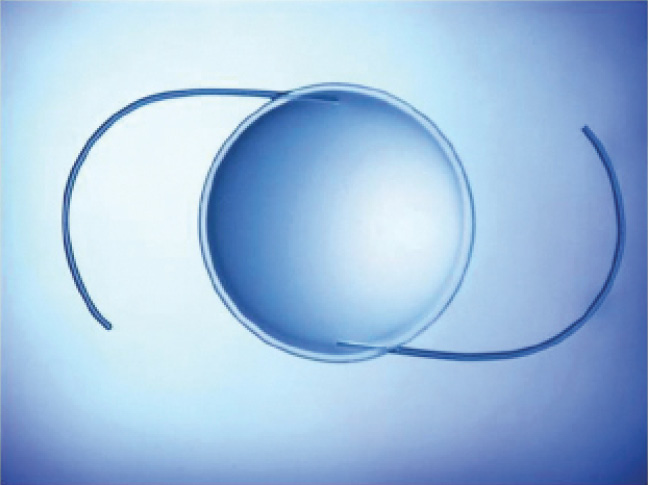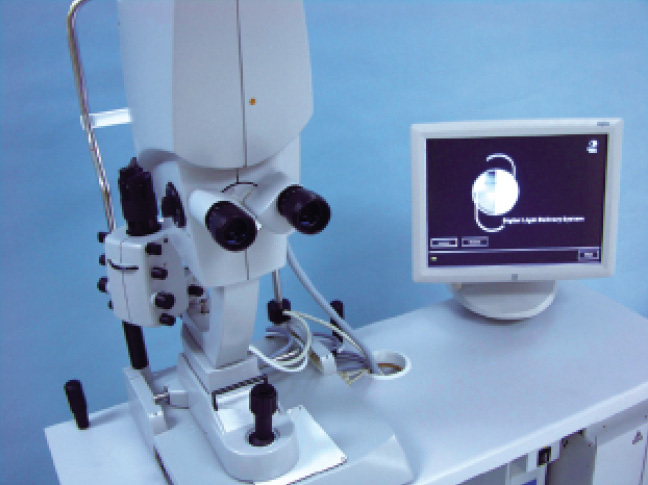What if ophthalmologists could eliminate refractive errors and customize patients’ vision by fine-tuning an implanted IOL? The Light Adjustable Lens (LAL; Calhoun Vision) has the potential to allow surgeons to do just that. Adjusting this photosensitive silicone IOL after implantation increases or decreases its power in one axis to correct sphere or astigmatism (Figure 1). The lens is commercially available in Mexico and Europe. In the United States, phase 2 trials for myopic correction are complete, and a phase 3 clinical study is being conducted at 15 sites across the country. A total of 600 eyes will be enrolled and treated to evaluate the safety and effectiveness of the LAL for reducing astigmatism and improving uncorrected visual acuity after implantation.

Figure 1. The Light Adjustable Lens.

Figure 2. The Light Delivery Device.
BACKGROUND
The three-piece LAL contains photosensitive silicone material. With Calhoun Vision’s Light Delivery Device (LDD), surgeons can adjust and refine the refraction after the LAL’s implantation. The LDD consists of a 365-nm ultraviolet (UV) source, projection optics, and a control interface that is mounted on a standard slit lamp (Figure 2).
The LAL was conceived by Daniel Schwartz, MD, an ophthalmologist at the University of California, San Francisco, and initially developed by Professors Robert Grubbs, PhD (recipient of the Nobel Prize in Chemistry in 2005), and Julia Kornfield, PhD, of the California Institute of Technology. Dr. Schwartz envisioned a light-adjustable lens that could have its refractive power modified after implantation via safe, noninvasive irradiation with UV light.
UNIQUE FEATURES
In many respects, the LAL is similar to a standard monofocal IOL: It has a 6-mm biconvex optic and an overall length of 13 mm. The LAL is available in 0.50-D increments from +17.00 to +24.00 D and in 1.00-D increments from +10.00 to +16.00 D and +25.00 to +30.00 D.
What makes the LAL different from traditional IOLs is the presence of proprietary photosensitive materials within the lens’ optic called macromers. After implantation, when the LAL is exposed to the UV light, polymerization of the macromers occurs in the region of the optic that is in the light’s path to produce a state of disequilibrium between the irradiated and nonirradiated areas. This process causes physical diffusion of the macromers, which changes the radius of curvature and the power of the lens.1 Modifying the irradiation dose and spatial irradiance profile changes the refractive power of the lens, adding or subtracting spherical power or eliminating astigmatic error. Spherical and cylindrical adjustments of up to ±2.00 D have been corrected in Europe and Mexico. The development of the LDD and the application of UV light to change the power of the LAL are based on years of laboratory and animal studies to determine the appropriate nomograms.2,3
Calhoun Vision has also developed software algorithms for international markets that permit the creation of a zone of added power in the central area of the LAL for the treatment of presbyopia. For markets outside the United States, the company is also refining its aspheric algorithms that use the controlled management of spherical aberration to induce extended depth of focus.
ADJUSTING THE POWER
Two weeks after the LAL’s implantation, patients return for an adjustment, which is performed at the LDD under pupillary dilation. A second adjustment may be applied if the refractive target is not achieved or if the ophthalmologist deems it necessary. Two lock-in treatments of the LAL’s power are then performed to prevent additional changes in the lens. During this postoperative period, patients must wear UV-blocking glasses to prevent exposure of the LAL to UV light, which could change the refractive power of the lens. Once the final lock-in treatment is complete, patients no longer need to wear the protective glasses.
INTERNATIONAL RESULTS
In a study of 28 consecutive eyes implanted with the LAL, Canadian surgeon Guillermo Rocha, MD, reported that, after adjustments and the final lock-in treatment, 89% of eyes had a residual manifest refraction spherical equivalent within ±0.25 D of the intended target, and 96% of eyes were within ±0.50 D. As for the reduction in cylinder, 100% of eyes had a residual cylindrical error of 0.50 D or less.4
At the 2013 European Society of Cataract & Refractive Surgeons meeting, German ophthalmologist Tobias Neuhann, MD, reported that, 2 years postoperatively, 94% of eyes (n = 24) fell within ±0.50 D of the intended refraction, and 100% of eyes achieved an uncorrected distance visual acuity of 20/32 or better. There was no difference in the outcomes between virgin and challenging eyes (13 eyes had undergone previous LASIK, two eyes had keratoconus, and nine eyes lacked a reliable axial measurement with the IOLMaster [Carl Zeiss Meditec, Inc.])5
LAL implantation and adjustments performed after implantation provided a precise refractive outcome in eyes that had previously undergone LASIK or PRK, according to a study conducted by Canadian surgeon Lawrence Brierley, MD. In a series of 35 eyes implanted with the LAL, the manifest refraction spherical equivalent was within ±0.25 D of the intended target in 74% of eyes and within ±0.50 D of the intended target in 97% of eyes.6
CONCLUSION
Results from international surgeons demonstrate the potential capabilities and advantages of the LAL, including predictable outcomes and customizable results. It is to be hoped that this IOL will prove to be safe and effective in its US phase 3 clinical trial and that the lens will become commercially available in this country in the near future.
1. Hengerer FH, Hütz WW, Dick HB, Conrad-Hengerer I. Combined correction of sphere and astigmatism using the light-adjustable intraocular lens in eyes with axial myopia. J Cataract Refract Surg. 2011;37:317-323.
2. Standstedt CA, Chang SH, Grubbs RH, Schwartz DM. Light-adjustable lens: customizing correction for multifocality and higher-order aberrations. Trans Am Ophthalmol Soc. 2006;104:29-39.
3. Schwartz DM, Sandstedt CA, Chang SH, et al. Light-adjustable lens: development of in vitro nomograms. Trans Am Ophthalmol Soc. 2004;102:67-74.
4. Rocha G. Refractive and cylindrical results in eyes implanted with a light-adjustable intraocular lens during cataract surgery. Poster presented at: The European Society of Cataract and Refractive Surgeons Annual Meeting; October 8-12, 2012; Milan, Italy.
5. Neuhann T. Improving refraction with the light adjustable lens: two year experience. Paper presented at: The European Society of Cataract and Refractive Surgeons Annual Meeting; October 6, 2012; Milan, Italy.
6. Brierley L. Refractive results after implantation of a light-adjustable intraocular lens in postrefractive surgery cataract patients. Ophthalmology. 2013;120(10):1968-1972.



